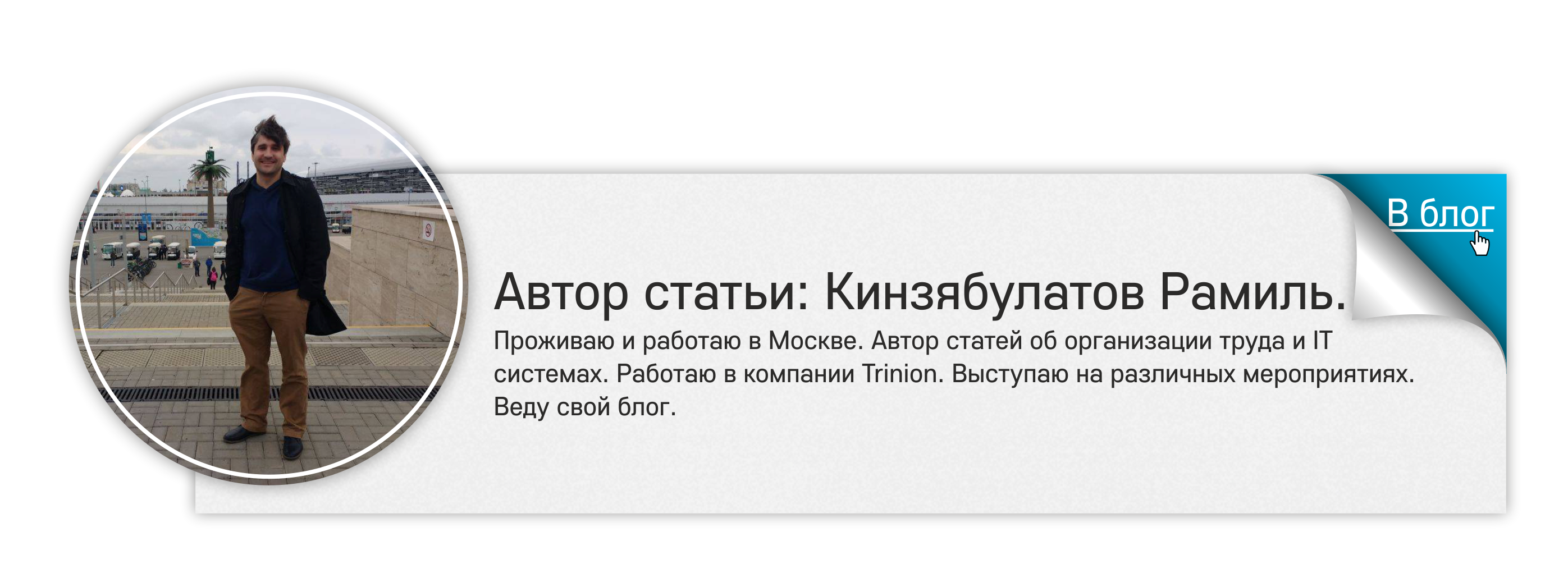1C CRM. Overview

Now, many companies quite often choose this system, because, as its name implies, it consists of two interconnected systems: from the Trade Management Department (working with an order, with a warehouse, managing delivery, finances, etc.) and CRM systems. This attracts managers and business owners, because, as a rule, customer relationship management goes hand in hand with trade accounting, and working in two separate systems is not always convenient and profitable.
But they turn to me about how to configure this system, since it causes difficulties for users. This, of course, is a big plus, that one system includes trade management and work with clients. But this also leaves a definite imprint on the functionality of the system, the advantages and disadvantages of which will be discussed in this article.
The 1C System Trade and Customer Relationship Management (CRM) is a product of 1C-Rarus, a joint venture of 1C and Rarus. The basis of this system is the configuration of the Trade Management Company 1C, and the CRM component was finalized by Rarus.
I will dwell on the CRM-component of this system. I will not dwell on the points directly related to trade. I will consider them only as part of customer relationship management.
')
I want to draw special attention to the fact that I work with small and medium-sized businesses, so all the recommendations and comments on the work of 1C: CRM, discussed in this article, relate primarily to small and medium-sized businesses.
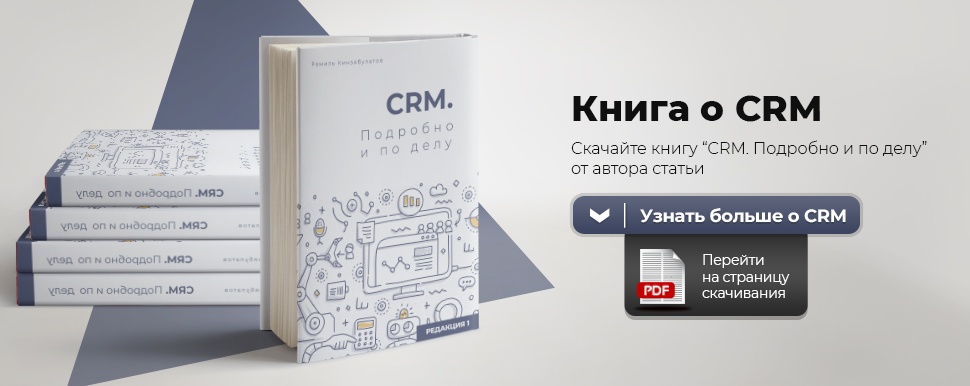 I also want to say that I expressed my opinion about 1C in the article “Why 1C is bad and why 1C programmers don’t like it so much ”, and it has not changed since then. Keep this in mind when reading the article.
I also want to say that I expressed my opinion about 1C in the article “Why 1C is bad and why 1C programmers don’t like it so much ”, and it has not changed since then. Keep this in mind when reading the article.There is a separate 1C: CRM system without the functionality of trade management, but it is still not in itself as valuable as in conjunction with the configuration of the Trade Administration. In this article, we are talking specifically about the 1C Trade and Customer Relationship Management (CRM) system, but for convenience, we will call it 1C: CRM in the article.
In the review, we will look at the 1C Trade and Customer Relationship Management (CRM) system, revision 2.0 (2.0.13.1) (http://solutions.1c.ru/catalog/crm-corp-20).
So, let's begin.
Delivery options
The 1C: CRM system comes in several editions.
1C: CRM. Basic version
1C: CRM. STANDARD
1C: CRM. TRAC
1C: CRM. Corp
These editions are distinguished by the presence or absence of one or another functional, which you can see and compare here rarus.ru/spb/task-solution-1c/business-process/comparisoncrm8.php
I want to draw your attention to the fact that in 1C: CRM configurations. Basic version and
1C: CRM. STANDARD important functions of a CRM system are absent altogether, therefore it is difficult to call them a CRM system. For this reason, in the review we are reviewing the 1C: CRM edition. PROF, which has a wide CRM functionality.
Licensing
When buying 1C: CRM, you will come across a marketing trick. In order for 1C: CRM to work, one license for the system will not be enough, you need to purchase a number of licenses: license, Trade management and customer relationship license, CRM PRO license, 1C license, 1C server license, Softphone 2.0 license
The license is sold in the Stand-Alone format - this is a “boxed” solution that you install on your own server. You can buy one or more licenses. You can work both in the file mode and in the client-server version. To work in client-server mode, users must have licenses to the server. As practice shows, a server license is needed because the system does not “fly up” on a file version with more than four users.
Below is the cost of licenses for a company of 10 users. We consider exactly 10 users, because even in a small enterprise, all employees usually work in the system: sales managers, purchasing managers, accounting, and company management.
| Name | Price | |
|---|---|---|
| one | 1C: Enterprise 8.Management of trade and customer relations (CRM) | 23,600 |
| 2 | 1C: CRM PROF. Red.2.0. Additional license for 10 jobs | 58,100 |
| 3 | 1C: Enterprise 8. Client license for 10 workplaces | 41,400 |
| four | 1C-Rarus: Softphone PROF, edition 2. License for 10 jobs | 28 500 |
| five | 1C: Enterprise 8.3. Server license | 50,400 |
| Total: | 202,000 |
Program code 1C: CRM partially open, partially closed. You can make changes to one or another functional, but there are external components that are not written in 1c - they are closed. One of these components is for 1C communication and software PBX (for example, Asterisk).
The program 1C: CRM is launched through a remote desktop or by connecting to the program directly.
Interface 1C: CRM
The 1C: CRM system interface practically does not differ from the 1C Trade Management 11 interface, since it was created on the basis of this particular system with a CRM component added to it.
There are not so many improvements directly related to the CRM system. It is necessary to understand that many things concerning the management of work with clients are already in 1C UT 11.
If you have already worked with 1C Trade Management or 1C Accounting, for you the work in the system will be understandable, but sometimes it is rather difficult to find one or another function due to an overloaded interface, partial duplication of information. Unprepared user first acquaintance with the program can scare.
Regarding the setting of forms - you can independently configure only the data that is already in the system. Add new data you need without the help of a programmer you can not.
Customer Information
Client information in 1C: CRM is entered into several directories - Contacts, Counterparties, Partners - this functionality has been completely transferred from the Trade Department 11.
That is, when registering a client, it is necessary to create 3 persons: Partner, Counterparty and Contact Person.
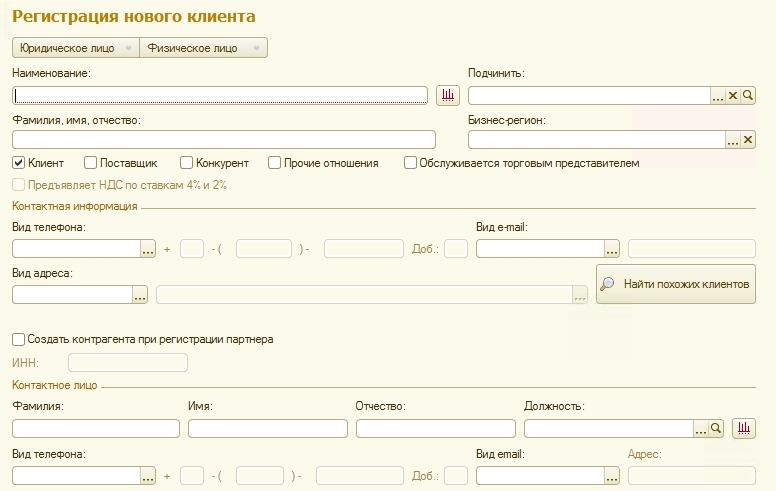
If everything is more or less clear with the Contact Person - one counterparty may have several contact persons - then the presence of two reference books of the Partner and the Counterparty raises questions.
Registering information about a business partner in two directories allows you to store in the database data on the complex structures of companies with which your company works. Your partner can be a holding working on behalf of several legal entities with which you need to separately control the settlements. And in this case, you register information about the holding in the Partner’s reference book, and information about legal entities in the Counterparties that are subordinate to this Partner.
If your company works with partners acting on behalf of one legal entity, or you work with individuals, you can keep information in the Partners and Contact Persons directories, or only in the Partners directory.
In the system of registration and storage of customer data 1C: CRM there is no such thing as a “lead”.
It was not by chance that in most CRM systems the notion of Lead was identified - a potential customer who had not bought anything from you, but only showed interest in your product or services. He just called or left a request on your site, it is still too early to add him to the list of clients, and to interact with him, as with your regular customers, you cannot yet. Such an entity as a leader in the 1C: CRM system, unfortunately, is not. And as a result, your client base consists not only of real clients, but also of “phantoms” who once turned to you, but never bought anything.
Yes, there are no leads in the program, but there are opportunities for refinement to lead such clients separately. Let me give you one example of how we implemented lead registration on one of the projects. An additional “Lid” requisite with the Boolean type was created in the partner card. Thanks to this props, customers could be sorted into real customers and leads. The conversion of the lead into the client in our case occurred automatically when the transaction was created.
Deal
To regulate the sale processes in 1C: CRM, transactions with customers are used. As part of the transaction, all stages of work with the client are recorded, starting from the moment of registration of the potential client to the time of shipment of goods to the client.

The transaction in 1C: CRM has a wide functionality:
- Here we can indicate the potential (the potential amount of the transaction) - enter it manually or on the basis of the primary demand of the customer specified in the transaction.
- It is possible to indicate the probability of a transaction - and do it both manually and calculated on the basis of statistics, expert evaluation of the likelihood of successful completion. The probability is calculated on the basis of such indicators as% of successful completed transactions at this stage, by manager, by partner, by type of transaction. Based on this data, the Calculated probability is displayed, which you can substitute in the field Probability.
- In the transaction, you can register the primary interest of the client and specify the channel advertising impact. This is necessary if advertising campaigns are conducted at the enterprise and it is required to find out the effectiveness of a particular campaign.
- In the transaction with the client information is recorded on the primary demand of the client. Here, information about the goods that the customer wants to purchase and the amount for which the customer expects to buy goods is randomly entered.
- Within the framework of the Transaction, interactions with the client on the transaction issues can be created and stored.
- On the basis of the transaction, it is possible to formulate tasks for the timely fulfillment of obligations to the client.
- If necessary, you can store attached files in the Transaction.
- On the basis of the Transaction in 1C: CRM, you can create trade documents (Commercial Offer, Sales Order, Sales, Work Execution Certificate, Order to Supplier, etc.) This is the functionality that almost all CRM systems lack.
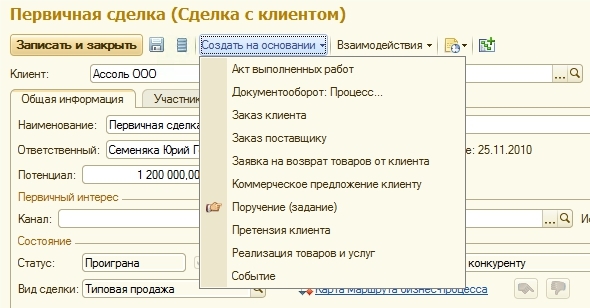
The transaction provides for 3 statuses: In operation, Won, Played. A newly created transaction will always have an In Work status. Further, in the course of working with the client, the manager himself determines the status that needs to be established: fix the winnings of the transaction or establish that it is lost. The reason for the loss of the transaction, you can specify, prior to the list of reasons relevant to your company. Subsequently, you can display a report for reasons of losing transactions, based on which you can make management decisions.
As for the stages (stages) of the transaction - here this moment is organized as follows. The list of stages of the sales process is specified in the Directory Stages of sales processes. This list already contains predefined steps, which you can use, the missing steps are recorded in the same directory. You can add any number of arbitrary steps to this list according to the sales processes used in your company.
The passage of each stage of the sales process can be tightly controlled by the business process, can be controlled by the manager or not controlled at all. This is determined by the type of transaction that is used when working with the client.
The program provides three types of transactions that determine the method of managing the transaction and the transition in stages:
- Other non-process transactions - in this type of transaction only the fact of the beginning and end of the work on the transaction is recorded, the stages for this type of transaction are not indicated at all. Non-process transactions are typically used to register tasks and interact with a client in long-term projects.
- Transactions with the manual transition to the stages of sales. This type of transactions is used if the company does not have strict control over the implementation of each stage. Stages are arbitrary. You can use existing predefined elements of the sales stages or add your own. The transition from one stage to another, the user will perform manually, with the possible skip of some stages, return to the previous stages. Transactions with manual transition - this is the standard functionality of most CRM-systems, where the user manually changes the transaction stage.
- Transactions that are described in the business process system. The main difference of this method of management from the previous one is that the sequence of transition from one stage of the management process to another is strictly regulated and described by the route map of the business process. You cannot skip a stage with this type of deal. At each stage, the corresponding users are given tasks and their implementation is monitored. We will dwell on business processes in more detail below.
At one enterprise, all three types of transactions can be used, and also in the process of working on a transaction it is possible to change the way the transaction is managed, that is, the type of transaction.
We now turn to business processes.
Business processes
At once I want to note that in many software products the business process is considered as a tool for generating actions under certain events. In 1C: CRM business process, rather, has a regulatory supervisory function and is a tool closer to BPM systems.
BPM (Business Process Management, Business Process Management) is a concept for the process management of an organization that treats business processes as special resources of an enterprise, continuously adapted to constant changes, and relies on principles such as clarity and visibility of business processes in an organization. by modeling business processes using formal notations, using modeling software, simulating, monitoring and analyzing business processes, the ability to dynamically rebuild models th business processes by the participants and by means of software systems.Wikipedia.
In 1C, business process modeling is performed in Route Maps. The program already has several pre-installed maps that can be used, but, as a rule, the standard options are not always suitable. Therefore, to reflect in detail the sale process or another process relevant to your company, you need to create your own route map.
Route maps describe the logic of a business process and all its steps, from the starting point to the completion point, in the form of a schematic representation of a sequence of interconnected route points.
Using the proposed graphic elements (Start point, End point, Action point, Condition point, Selection point, Split / Merge point, Nested business process point) - a business process diagram is created indicating what conditions the user should perform .
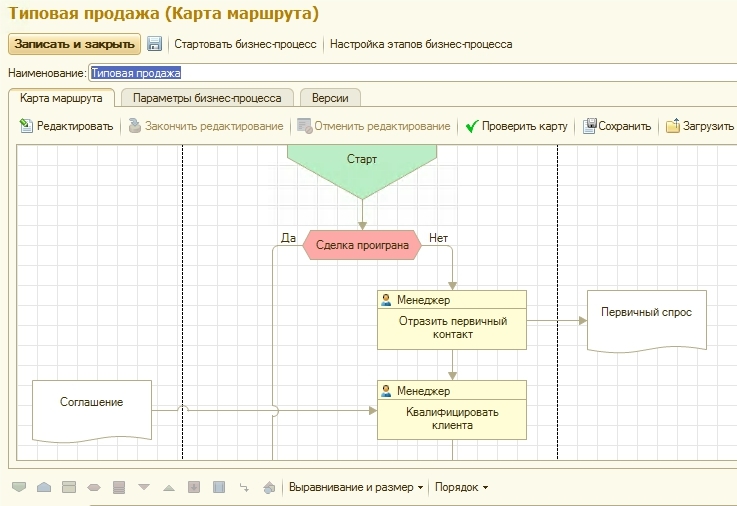
When you start a business process at each stage of the transaction, the user is formed with a task that lists the actions that must be performed to proceed to the next stage. Thus, the main mode of operation of a manager with a transaction, if it is managed by a business process, is to work out those tasks that are automatically generated for him and displayed in the My Tasks list.
Consider a specific example of a business process. Suppose we are already at the stage of a commercial offer, after which the client can either agree to place an order or refuse it. On the route map, is this indicated by a condition point Customer agree? with options Yes and No , implying appropriate actions. What happens in the program?
- After making a commercial offer, the user will be formed a task in which the question will be. The client agrees?
- The user selects one of the proposed response options.
- If you select Yes, the user will automatically be sent a new task - to place a customer order , which can be arranged directly from the same task.
The idea that the program itself leads the user step by step from one stage to another is, of course, good. It should be noted that without a specialist (1C programmer), this functionality cannot be configured. Moreover, an expert should know well not so much programming as to be able to work with business processes, since this functionality is very different from everything else that is in the 1C system.
I recommend to work as follows: the consultant draws the business process and describes the necessary actions during the transitions from one stage to another, coordinates it with the 1C programmer and only then shows it to the customer. Why you can not immediately show the customer - because in 1c business processes have limited functionality. In 1C there is no full-fledged BPMS, it must be borne in mind.
Interaction with the contact
In the CRM system it is necessary to record interactions with customers - inbound and outbound. This is necessary both in order to be aware of the interaction with a specific client, and in order to have analytics on interaction with clients, on the work of managers, etc., on the basis of which management decisions can be made.
Email is one of the types of customer interactions provided for in 1C: CRM.
As for sending single email messages based on templates, in this question in 1C: CRM everything is done at a height: the system contains various letter templates and a convenient constructor. You can form a printed form of the document on the fly and immediately send it to the customer, or notify him of the fact that his order has been shipped.
In addition to the fact that you can create templates for single messages, you can also use CRM for mass mailing. But unfortunately you will not receive a full-fledged beautiful html letter.
Statistics on letters and mailings in 1C: CRM, too, unfortunately, no. By statistics, I mean such indicators, for example, as% of opening letters,% of clicking on links, etc. Integration with mailing services in 1C: CRM either.
SMS distribution
You can not pass by SMS-mailing. Sending SMS from the program is a very effective thing. You can notify the client about the status of his order, or create a mass mailing as part of a marketing campaign. If a certain event occurs in the program, you can create automatic SMS.
In the system, you can send single SMS, created manually or by template. And also provides for the possibility of mass distribution of SMS-messages.
Phone calls
The cornerstone of any CRM system is automated telephony. It is difficult to imagine a modern CRM system without integrated telephony.
The 1C: CRM system itself does not provide for communication with telephony - there is a product for this called 1C-Rarus: Softfon. 1C-Rarus: Softphone provides integration with the office PBX (telephone exchange) and is necessary so that you can record outgoing and incoming calls in the 1C: CRM system. 1C-Rarus: Softphone is an embedded product. It integrates into the configuration and becomes the third part of the system along with UT 11 and CRM.
1C-Rarus: Softphone requires a license. This has already been mentioned above: 1C-Rarus: Softphone PROF, revision 2. License for 10 jobs 28 500 rubles.
The softphone has connection to various systems (I integrated with Asterisk). You can call using the Softphone that comes with it, or you can use Zoiper or Bria, or a hardware phone with VoIP.
Softphone can not be finalized, its code is closed and written not in 1c language.
Softphone allows you to receive information about the caller, to make outgoing calls - that is, he copes with his minimum task. But still, the fact that the Softphone is a separate product is felt in the process of work. When a call arrives, it does not immediately fall into 1C: CRM, but only when the user command “Send in 1s”. Of course, on the one hand, this is good: third-party calls will not get into the system, but there is a danger that not all customer calls will get into the database.

You can make calls using the Softphone, but setting it up by itself is not a trivial matter, my system never “started up” at once.
The phone call card itself offers ample opportunities, for example, such as labor accounting, event participants, the client’s primary demand ... Use these opportunities or limit to the Description field, where the result of the call is recorded in free form - you decide.
Based on the phone call card, you can create documents (Transaction, Order, etc.), other interactions, tasks.
The 1C: CRM system also provides for the possibility of registering telephone calls. This feature is called Telemarketing. Telemarketing provides the ability to create a dial-up list manually, either by segment, or based on the results of a report. In a telemarketing document, you can write a free-form phone call script. Telemarketing provides the simplest analytics: the number of calls processed, the number of under calls.
However, in the document Telemarketing there is no possibility of fixing the result of the call. To do this, you have to create a phone call event. There is also no possibility of creating, for example, a deal or task based on a call recorded in telemarketing.
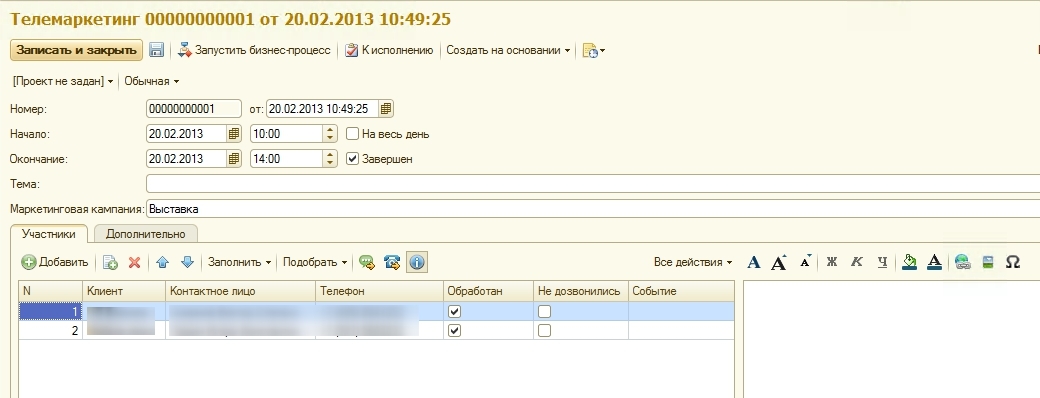
Thus, telemarketing is, rather, a tool to control employees making calls. It records the fact of having called the customer or not, rather than the result of the call.
Summarizing the review on the part of interactions with the client, I want to say that the functionality in this matter at the moment leaves much to be desired. As a result of the merging of two configurations (CRM and Trade Management), not one extended, improved customer interaction functionality was formed in the system, but two: Interactions and Events, which are essentially the same, and it is not clear what to use as a result. That is, the system has no coherent light logic of working with the client. Before starting to interact with the client, the user of the program must think carefully about what he will use and how he will do it.
Planning and work with tasks
For any CRM system, the ability to plan, set and work with tasks and reminders is important. This functionality is so necessary for the timely fulfillment of obligations to customers.
And in this issue, we again encounter functional imperfections. Of all the possible documents and objects of the program, we can create a task, in the program it is called the Order (Task). However, when we go to the Organizer section, where all events and tasks are stored, we see the following picture: there is a My Tasks section, there is an Assignments section (which, by the way, is no longer used in the program, but is preserved in the interface), there is no Instruction section.
The fact is that the Order is a pre-established business process consisting of two stages: execution and verification. When creating an order, the following occurs:
- the task is automatically formed to the Contractor
- The contractor must accept the task for execution.
- The contractor must complete the task
- the task “Check the task of such and such” is automatically formed, which is sent to the Author of the first task
- after verification, the task may be accepted by the author, or returned to the Contractor with a comment, and the whole chain begins anew.
Perhaps the scheme is convenient in the interaction of different employees, but if the manager wants to schedule the task to himself, this whole chain is useless.
Yes, from the program's objects, you can schedule interaction with the client, which will later be reflected in the calendar, and only in the calendar. This task will not be duplicated anywhere as a planned interaction, and this is also not very convenient with a large amount of planned actions.
Reporting
An important component of any CRM-system is reporting. It is important that the reports are visual and provide information aimed at making management decisions. Let's see how reporting is organized in 1C: CRM.
Take the main report of any CRM-system - Sales Funnel. The sales funnel demonstrates the distribution of transactions by sales stages from the first contact to the shipment of goods.
Sales funnels in 1C: CRM two. The report, which is displayed in the interface of the subsystem "Work with clients, sales" does not include analytics on transactions. There are data on documents in general, on the execution of orders, on customer complaints and on sales, but there is no data on the transaction at all.

But if you go to Reports for the Work with Clients, Sales subsystem, then in the Transactions with Clients section, we will see another Sales Funnel report. There will already be analytics exclusively on transactions, in various cuts and types.

Again, the merger of two configurations in the system resulted in not one extended, improved report providing more analytics, but two reports having exactly the same name, located in different places, one of which is not easy to find for an unprepared user.
Duplication is observed in other reports. As for reporting in general, it is widely represented both by reports in the field of trade management and CRM reports (analysis of interactions, the reason for the loss of transactions, the efficiency of transactions, etc.). Related reports in these two areas are still in 1C : CRM no. I mean reports such as, for example, the ratio of the number of phone calls to the number of transactions, to the number of successful transactions; effectiveness of marketing campaigns (profit as a result of, for example, email or sms-mailing). While such reports 1C: CRM can not boast.
Escort
Of course, the system is constantly updated (UT is updated, CRM is updated, the platform is updated), that is, buying 1C: CRM you get the whole bunch of advantages and disadvantages of the 1C system. You can read about this in my other articles. However, we have enough 1c specialists, so you shouldn’t have problems with support and setting up the program.
API
As for the integration of the 1C: CRM solution with other systems, there are no ready-made integrations. I don’t have my own API 1C: CRM, the UT 11 configuration API is used here. I can say that this API is more than enough.
Summary
From the advantages of the 1C system: CRM can highlight the following:
- Customer Relationship Management and Trade Management are in the same system, which is convenient for quick paperwork. All work takes place in one program.
- Convenient transaction management. The transaction in 1C: CRM has broad functionality and can be managed both manually and guided by business processes.
- A huge number of 1c specialists on the market, so support should not cause problems
The disadvantages of the system are:
- Some components important for CRM are missing (Lead; Integration with the site for collecting leads; Integration with social networks; Mobile version of CRM)
- The complexity of the refinement
- Cumbersome system interface and intricate functionality
- Excessive number of different settings
Source: https://habr.com/ru/post/296406/
All Articles
